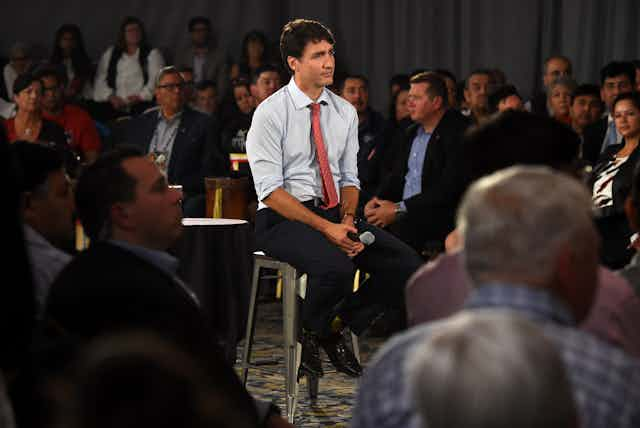Prime Minister Justin Trudeau has offended, humiliated and hurt several communities in Canada. The images of Trudeau in blackface invoke vile, racist and offensive stereotypes that have been used to deny the common humanity of Black communities across time.
Trudeau wore blackface on several occasions, including at an “Arabian Nights”-themed party where he also wore a stereotypical outfit. He has apologized for the blackface.
Canadians are now reflecting on the impact and significance of the prime minister’s apologies.
Leadership matters
In her recent book, Leading With Dignity author Donna Hicks, based at Harvard’s Weatherhead Center, says leaders play a significant role in creating institutional cultures, including governments. She argues that leaders must genuinely accept other identities if they want to promote the equal dignity and worth of all people.
Trudeau’s conduct ridicules racialized communities. It signals to them that they are second-class citizens. His behaviour must be understood in political and social context.

Trudeau uses anti-Arab clichés in politics
The prime minister invokes anti-Arab tropes when he criticizes Palestinian advocates and their allies who support Boycott, Divestment and Sanctions (BDS) against Israeli occupation. For example, at a town hall in St. Catharines, Ont., in January 2019, Trudeau asserted that those who support BDS violate “Canadian values.”
People can disagree on the purpose or effectiveness of BDS.
But Trudeau’s decision to declare his opponents as un-Canadian is troubling. It invokes anti-Arab stereotypes and can be linked to a larger pattern of discrimination faced by Arabs and Muslims in Canada, groups that are often improperly conflated.
In a recent paper from the Journal of Law and Social Policy, “All Arabs Are Liars,” I examined a sample of human rights cases for common anti-Arab and anti-Muslim stereotypes. My analysis confirmed that Arabs and Muslim are stereotyped as un-Canadian or disloyal to Canada.
Stereotypes impact people’s lives
Stereotypes or negative tropes are not simply insulting. They help maintain a racialized status quo. They cause us to misjudge other people’s motives, abilities and actions.
For example, after the Sept. 11 terrorist attacks, stereotypes influenced the decisions of Canadian officials who falsely concluded that Maher Arar, a Canadian citizen, engineer and father of two, belonged to a foreign terrorist group. The officials’ decisions reflected the belief that Arabs and Muslims are not true Canadians. Such thinking contributed to Arar’s overseas torture. It is also evident in the torture of other Canadian Arab, Muslim men in several overseas instances as determined by a federal commission’s inquiry.
Various studies have confirmed that Arabs and Muslims increasingly face discrimination and stereotyping in policing and national security surveillance. Arabs and Muslims also face discrimination at border sites, public spaces, workplaces, service counters and airports
Arab Canadians face racism
In a recent survey of Arab communities in Ontario undertaken on behalf of the Arab Canadian Lawyers Association with the support of the Law Foundation of Ontario, sociologist Suzanne McMurphy and I found that 27 per cent of people surveyed tried to hide their Arab identities.
When asked why one person explained it was because of the “prejudice and stigma associated with being Arab.” Another said: “Because it is clear to me that racism exists against Arabs and open membership can negatively affect me in the hunt for jobs.”
Unlike U.S. President Donald Trump, the Liberal government has not targeted Arab and Muslim communities. But, it has allowed anti-Arab and anti-Muslim practices to continue. It has failed to explicitly examine how its own policies diminish groups and perpetuate racial inequalities.
A show of diversity is not equity
Some point to the diversity of Trudeau’s team as a sign of his commitment to equality. But diversity and equality are not the same.

Feminists use the phrase “add women and stir” to describe the practice of including women without changing subordinating structures. The same tokenism can be taken towards racial equality.
Trudeau’s team is diverse. But the question is not simply “who does he include?” The problem is also: “On what terms does he include them?” A former Liberal adviser suggests the Trudeau team does not actually value diversity. It simply wants votes from diverse groups without fully including them in its power structures.
Meanwhile, the prime minister acknowledges that racialized people in Canada face discrimination. His apology used terms like “micro-aggressions,” “unconscious bias” and “systemic discrimination”.“
But it’s not clear that he’s internalized those concepts.
Until the prime minister demonstrates a real grasp of the dynamics of discrimination, his apologies will ring hollow.

